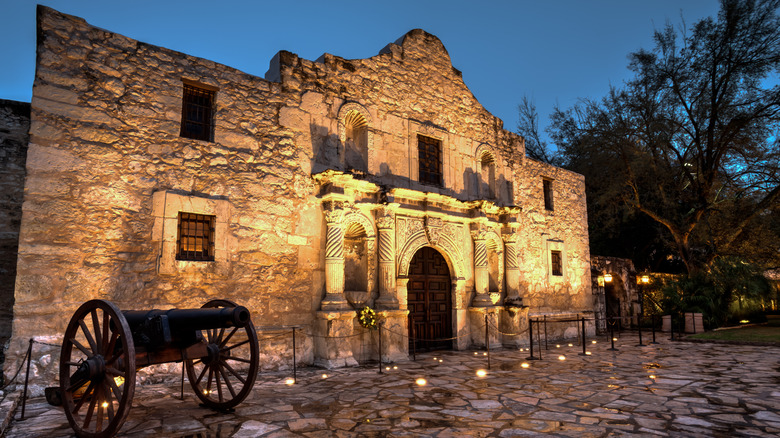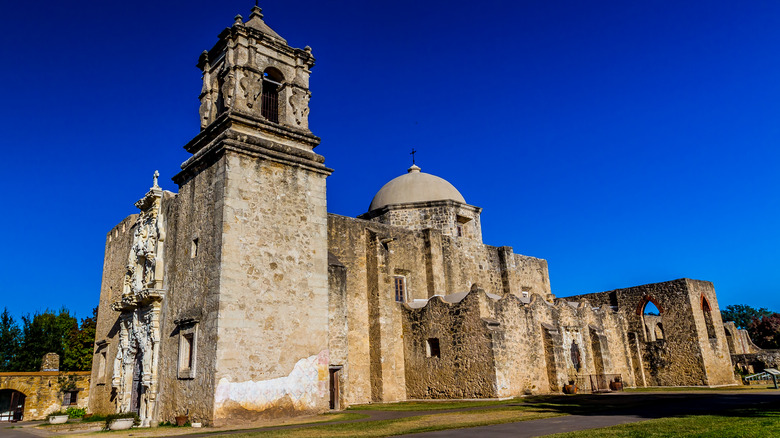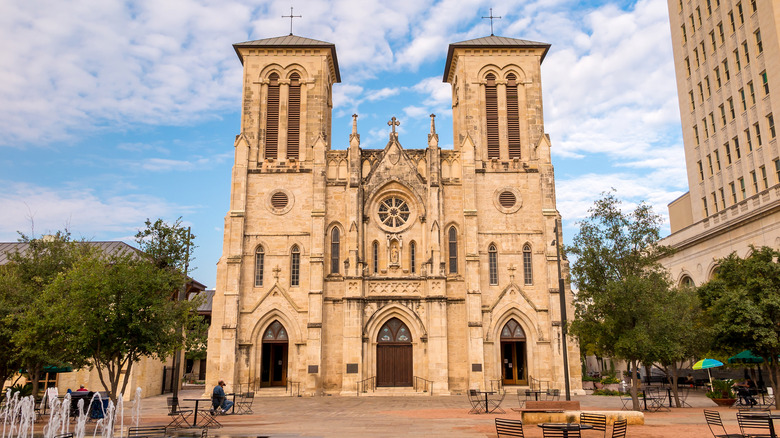This Texas City Is A Must-Visit Destination For History Buffs
Even if you've never set foot in San Antonio, Texas, you may remember its association with an important historical landmark: the Alamo. The Spanish-mission-turned-fortress and famous site of the Battle of the Alamo in 1836 still pops up everywhere from history classes to the TV quiz show "Jeopardy." The Shrine of Texas Liberty — previously the Mission San Antonio de Valero — is where Davy Crockett and other fort defenders made their fabled last stand. Soldiers later took up the battle cry, "Remember the Alamo," in the Mexican-American War, firmly lodging the place in myth and memory.
As a symbol of San Antonio, the Alamo has since been immortalized in everything from Disney and John Wayne movies to the name of the Alamo Drafthouse theater chain. The city itself grew up around the Alamo, and the mission compound continues to draw travelers from all over the world. It even attracted the interest of British musician Phil Collins, whose collection of Alamo artifacts is now on display at the compound. In a 2023 USA Today poll, the Alamo also beat out well-known places like Central Park and the Golden Gate Bridge as the country's best free tourist attraction.
As integral as the Alamo might be to Texas history, however, there's more to San Antonio than just this one landmark. In fact, the Alamo is but one of several Spanish missions in the city that have collectively been inscribed as a UNESCO World Heritage Site.
From the Alamo to the missions of San Antonio
For over a century, the Daughters of the Republic of Texas served as the Alamo's caretakers. However, in 2015, the State of Texas took full control of the site's management. That same year, most of the San Antonio Missions National Historical Park joined the Alamo in becoming part of the state's only World Heritage Site.
The park itself consists of four beautiful Spanish missions. All of them are spread out along the San Antonio River basin and were founded in the late 1600s or early 1700s. Mission Espada, the oldest of the four, and Mission Concepcion, the oldest unrestored stone church in the U.S., are both National Historic Landmarks. Mission San Jose is the largest of the four and a National Historic Site, while Mission San Juan is listed in the National Register of Historic Places. Espada Aqueduct, America's oldest Spanish aqueduct, aided in water distribution and is also part of the park. To this day, all four missions still function as active church parishes under the Archdiocese of San Antonio.
What gives these missions such great historical value from UNESCO's perspective is how they show two distinctly different cultures entwining to produce a new way of life. On one side, there were the Spanish, who sought to establish religious colonies in the New World. On the other side, there were indigenous people like the Coahuiltecans, who adopted an agricultural lifestyle among the Spanish and helped influence the design of their Catholic churches.
History along the River Walk
One way to get a feel for how the San Antonio Missions are all connected is by tracing their path along the San Antonio River. The Alamo is the farthest upstream, and it's only a few minutes on foot from the San Antonio River Walk, the most-visited tourist attraction in Texas. Known for its colorful umbrellas, Casa Rio is the River Walk's oldest restaurant. One of the many Tex-Mex options on the menu is a cheese enchilada plate that has been served since 1946.
While the River Walk is perhaps most renowned for its downtown part where you can take boat cruises, that area only covers a few miles. The full River Walk is 15 miles long, and a section called the Mission Reach takes up over half of it. This section is more like a riverside park, with canoeing, cycling trails, and public art installations. As its name implies, the Mission Reach also provides access to sites in the San Antonio Missions National Historical Park.
The four missions are free to enter, as are the Alamo grounds. However, you need to reserve a free ticket to visit the Alamo Church. Other historical sites near it and the River Walk's downtown stretch include the Spanish Governor's Palace, which now operates as a museum, and the Notre Dame-esque San Fernando Cathedral, America's oldest continuously operating cathedral. Together, these places will give you a fuller picture of San Antonio's rich history beyond the Alamo legend.


